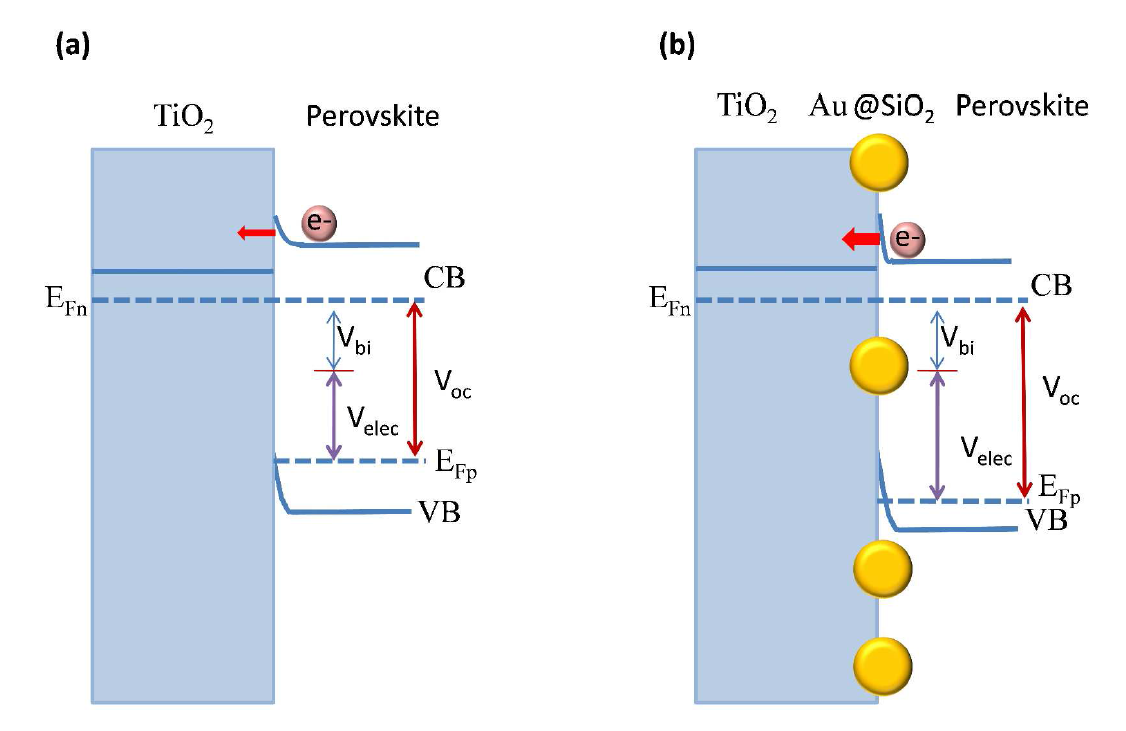When discussing interfaces issues with perovskite solar cells, Prof. Iván Mora-Seró from Institute of Advanced Materials, Castelló (Spain) is one of the most prolific scientists. Some month ago, he explored the use of gold nanoparticles at the interface between the electron sensitive contact and the perovskite material TiO₂ in perovskite solar cells.
Eliminating the plasmonic effect hypothesis
Previous studies used gold nanoparticles to show the existence of a plasmonic effect leading to enhancements of the solar cells efficiencies. During our discussion, Iván was very sceptic about the fact that a real plasmonic effect was behind the efficiency enhancement in some of the previous works in perovskite solar cells:
I do not think it is the real interpretation in some cases leading to increase in efficiencies of perovskite solar cells. When my visiting student Naemeh Aeineh wanted to analyse such an issue with gold nanoparticles, I was reticent but finally I gave her a half-hearted green light. She realized that no significant effect could be found by focusing on mixing the nanoparticles with the TiO₂ mesoporous scaffold as would be expected from a plasmonic effect. However, she observed a significant effect when the nanoparticles were deposited at the interface between two layers of TiO₂. The nanoparticles (NPs) used were core/shell Au@SiO₂. They placed them at the interface between the electron collector and the perovskite material. Thus, by affecting these interfaces, they managed to change the electrostatic potential, that created free carriers at the interfaces.
Observing different phenomena
With the work they carried out, they observed different phenomena. The first was that the addition at the electron selecting interface of Au@SiO₂ leads to an increase in the performances of the perovskite solar cells. A deeper observation with different techniques allowed Prof. Iván Mora-Seró and his team to understand why.
Light scattering plays a crucial role in this enhancement:
When illuminating materials, one can observe very often light scattering. The nanoparticles diffuse the incident light, leading to an increase in the efficiency. However, we are also observing a quenching of the photoluminescence, also associated with the fact we improved the charge separation properties, indicating that the effect of the interfacial NPs is not just a scattering effect.
The quenching means the electrons collected are not involved in photoluminescence properties of perovskite solar cells. That is due to the fact that the nanoparticles enhance the electrons collection hence fewer photons are involved in luminescence, quenching the luminescent spectrum.

That electron collection increase is shown by an increase in the electrostatic potential and an increase in the open circuit potential (VOC), but there are much research to be done in this field:
We are sure that we observe light scattering effects, but also something else, because we increase the injection properties in our system. Because we are increasing the VOC, electron probably would be injected in channels into the perovskite. We need further study to prove this and are working with colleagues on numerical simulations to see if it is such important to manage the electric field. But it is just a hypothesis for the moment!
No wonder he will manage to find shreds of evidence!
A size effect
When working with nanoparticles, one must always think about their size-effects. Because nanoparticles are small objects, their ratio surface/volume is very important. That enhances the role of interfaces within these materials. Moreover, their small size lead in this case to small channels, that is very important for the perovskite-electrode contacts. In fact, it could lead to a decrease in ion mobility.
In other applications, nanoparticles are used for the fact they help the crystallisation of the perovskite. If we manage to control these process with nanosized objects, it could lead to lower ion mobility and more stable solar cells by affecting recombination at the interfaces.
As a conclusion, we will still hear about the role of interfaces in solar cells for a long time. Last week, Iván has published a review about it. I am sure it will be a hit in the community, leading the though towards more stable and more efficient perovskite solar cells.
 0000-0002-6484-2157
0000-0002-6484-2157